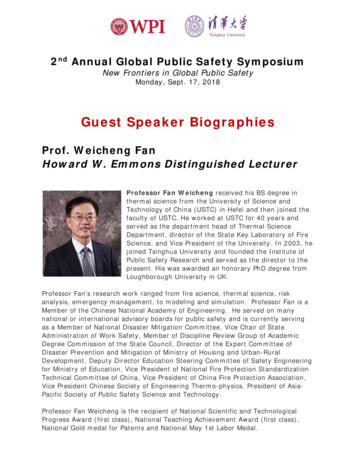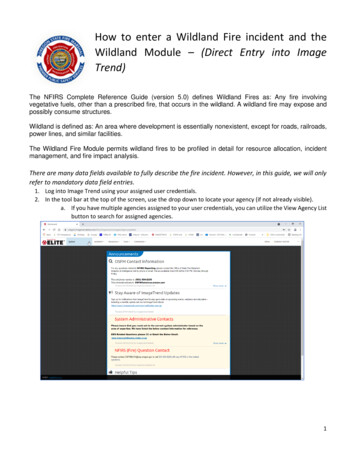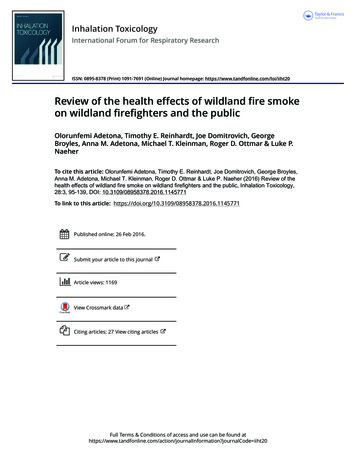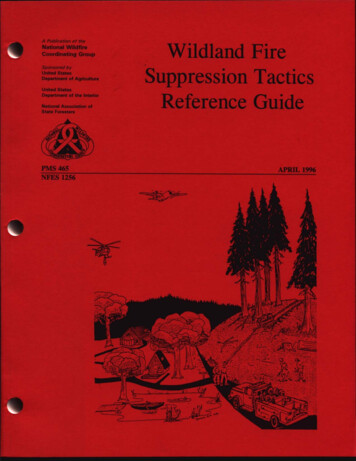
Transcription
A publication of theNational WildfireCoordinating GroupPMS 551Clinical TreatmentGuidelinesfor Wildland FireMedical UnitsJuly 2012
Clinical TreatmentGuidelines for WildlandFire Medical UnitsJuly 2012PMS 551Sponsored for NWCG publication by the NWCG Risk Management Committee. Prepared and maintainedby the Incident Emergency Medical Subcommittee (IEMS). Questions regarding the content of thisproduct should be directed to subcommittee at BLM FA NWCG IEMS@blm.gov.This product is available electronically at: https://www.nwcg.gov.Previous editions: none.The National Wildfire Coordinating Group (NWCG) has approved the contents of this product for theguidance of its member agencies and is not responsible for the interpretation or use of this information byanyone except the member agencies.It is NWCG’s intent to specifically identify all copyrighted content used in NWCG products. All otherNWCG information is in the public domain. Use of public domain information, including copying, ispermitted. Use of NWCG information within another document is permitted, if NWCG information isaccurately credited to the NWCG. The NWCG logo may not be used except on NWCG authorizedinformation. “National Wildfire Coordinating Group”, “NWCG”, and the NWCG logo are trademarks of theNational Wildfire Coordinating Group.The use of trade, firm, or corporation names in this publication is for the information and convenience ofthe reader and does not constitute an endorsement by the National Wildfire Coordinating Group or itsmember agencies of any product or service to the exclusion of others that may be suitable.
July 2012ContentsPreface . iiiDental . 1Ear . 4Epistaxis . 7Eye . 9Gastrointestinal. 12Genitourinary . 15Headache . 18Insect Stings and Bites . 19Integument (Skin). 23Burns . 26Musculoskeletal . 29Respiratory . 33Snakebites . 38Throat. 40Glossary . 43TablesTable 1. Oxygen Saturation at Altitude . 33Table 2. Acute Asthma - Categories of presentation . 36Table 3. Cold, Flu, or Allergy. 42Table 4. Symptomatic Relief . 42Clinical Treatment Guidelines for Wildland Fire Medical Unitsi
July 2012PrefaceIn 2010, the Incident Emergency Medical Subcommittee (IEMS), operating underthe authority of the National Wildfire Coordinating Group (NWCG) - RiskManagement Committee, completed the document, Interim Minimum Standardsfor Medical Units Managed By NWCG Member Agencies. The document was thefirst of several to be developed that will address the need for uniform standardsand safe delivery of medical care provided by Emergency Medical Services(EMS) personnel at wildland fire. It focused on recognizing current practices andrecommending standards to medical units for; promoting the use of licensedpersonnel within their scope of practice, state EMS office notification, applicablerules and jurisdictions, medical direction, communications, patient transportationand medical equipment, medication and supplies used.The IEMS also committed to developing wildland fire specific protocols and thisdocument, Clinical Treatment Guidelines for Wildland Fire Medical Units, PMS551, is the finished product. A task group of physicians with diverse backgroundsin wildland fire medicine, wilderness medicine and emergency/ clinicalbackgrounds reviewed this document and provided valuable input. Theseguidelines where developed with the expectation that the typical appropriateBasic Life Support (BLS) or Advanced Life Support (ALS) EMS interventions willbe provided as needed so we did not include detailed protocols for EMS medicalor trauma patient care, which already exists. Rather, we focused on guidance forthe unique differences and challenges associated with remote sites andexpanded evaluation skills needed for patient care issues such as:1) assisting a patient with first aid and self-care health management;2) triaging conditions for recognition of appropriate self-care assistancevs. need for transport to clinical medical care; and3) initiating urgent/EMS care using appropriate and predeterminedtransport modes.Clinical Treatment Guidelines for Wildland Fire Medical Units was developedusing categories by body system or specific body part along with the mostcommon environmental emergencies seen during fire incidents. Each bodysystem, body part or environmental emergency included begins with the boxedheader of “Triage Priority”. The following four conditions are used to determinewhen and with what degree of urgency a patient transport occurs if one or moreof the bulleted qualifying criteria are present:Emergency Condition- Transport patient by most rapid, appropriatemethod available to definitive emergency medical careClinical Treatment Guidelines for Wildland Fire Medical Unitsiii
July 2012Urgent Condition – Hospital Evaluation is necessary, ambulancetransport as neededSemi-Urgent Condition – Physician evaluation is necessary, timelinerecommendation for semi-urgent is that day, within 8-10 hours or first thingthe next morningRoutine Condition – Medical Unit may provide access to over thecounter medications, diet or fluid recommendations, first aid care andremediesBefore using these guidelines EMS personnel must be aware that stateregulations, an on-site physician, on-line medical control or off-line directivesfrom a medical director with jurisdiction may supersede these guidelines.Additionally, supplemental training of EMS personnel will be necessary in theareas of over the counter medications, clinical evaluations, patient reassessment,and diagnostic equipment. Any supplemental training should meet respectivestate or local regulations and policy.Finally, considerations for multiple patients with potentially contagious diseasesand integration of services with federal, state, tribal and local public healthofficials may become necessary.IEMS continues to support medical units of NWCG member agencies and foradditional information and updates, please visit the IEMS website ncy-medical-subcommittee.Incident Emergency Medical SubcommitteeClinical Treatment Guidelines for Wildland Fire Medical Unitsiv
July 2012DentalTriage PriorityEmergency Condition - Transport patient by most rapid, appropriatemethod available: Dental infection causing airway compromise Uncontrolled dental or oral bleedingUrgent Condition - Hospital evaluation, Ambulance transport as needed: Dental abscess (infections) Dental trauma resulting in avulsed teeth Uncontrollable dental painSemi-Urgent Condition - Physician evaluation: Dental pain (controlled by medications) Dry socketRoutine Condition - Medical Unit Treatment: Dental caries (cavity) without painGeneral: The most common cause of dental pain is tooth decay or pulpal disease.Pulpal disease has three phases:o Hyperemic - The vascular system responds to an external stimulus,such as dental caries or dental trauma; this is a reversible condition.o Pulpitis - The pulp becomes infectedo Pulpal necrosis - The pulp dies; fluid and pressure build, causing painTherapeutic intervention consists of analgesia and referral to a dentist.ToothachesSigns and Symptoms: The most common cause of toothaches is pupal disease or dental caries. This type of pain is paroxysmal and usually begins with heat and /or coldstimulus. Irreversible pain indicates that the tooth will require either a rootcanal or extraction. This pain usually occurs spontaneously and continues to worsen,especially at night when intracranial pressure builds. The tooth becomes extremely sensitive to heat and cold. The pain may be reversible if the decay can be removed and the tooth isrestored.Clinical Treatment Guidelines for Wildland Fire Medical Units1
July 2012Dental - ContinuedToothachesTreatment:Routine – Medical Unit evaluation and treatment Topical OTC analgesic (eugenol, oil of clove).OTC Analgesic – Follow package insert dosage instruction.Warm packs to areaReferral to a dentist if pain persists or infection is present.Avulsed TeethSigns and Symptoms: Teeth that have been torn from the mouth by trauma. If found within the firsthour the teeth may be implanted.Treatment:Urgent – Hospital evaluationIf found within 1 hour and patient is alert and oriented: Rinse tooth clean Irrigate the wound/socket Re-implant the tooth in the original socket OTC Analgesic – Follow package insert dosage instruction.If greater than 1 hour: Place the tooth in saline solution Check for excessive bleeding from the gums or pulp. As these injuries are frequently associated with head injuries, be sure tocheck the mouth and pharynx area for pieces of the tooth and debris thatmay obstruct the airway.Clinical Treatment Guidelines for Wildland Fire Medical Units2
July 2012Dental - ContinuedDental AbscessSigns and Symptoms: Abscess at the root of the tooth usually resulting from pulpal necrosis,which is a result of caries or trauma. Periodontal (recessed pocket between the tooth and gum) abscesses.Treatment:Semi-Urgent – Physician evaluation These all require dental referral for drainage of abscess. Therapeutic intervention consists of drainage of abscess by a dentist. Local measures for pain controlo OTC Analgesic – Follow package insert dosage instructiono Warm packs on the areao Warm hydrogen peroxide (1.5 %) rinses every 2 hours.o If drainage is present, position for drainage out of mouth and beprepared for emesis.Dry SocketSigns and Symptoms: Dry socket usually occurs 3 - 5 days after tooth extraction, when a bloodclot is lost and bone is exposed.Treatment:Semi-Urgent – Physician evaluation Irrigate socket with saline OTC eugenol (oil of cloves) moistened cotton ball packed into the socket. OTC Analgesic – Follow package insert dosage instruction. Dental referral if pain persists.Clinical Treatment Guidelines for Wildland Fire Medical Units3
July 2012EarTriage PriorityEmergency Condition - Transport patient by most rapid, appropriatemethod available: Traumatic ear injuries Sudden deafness Fever above 101.5 F Retained foreign bodies with symptomsUrgent Condition - Hospital evaluation, Ambulance transport as needed: Acute tympanic membrane perforation Continued ear pain without fever or physical findings Patients with underlying illness (e.g. diabetes, multiple medical problemsand medications)General:There are three requirements for proper ear examination using an otoscope: Good illumination Magnification Patient comfort including adequate physical control of the patient,including proper positioning and sedationAcute Cellulitis of External EarSigns and Symptoms: Redness of external ear Swelling of external ear Tenderness of the external ear Fever greater than 101.5 FTreatment:Semi-Urgent - Requires physician evaluationAcute External OtitisSigns and Symptoms: Itching Severe ear pain Ear tender to touchSwelling of the canalInfection of the external portion of the earPurulent material in external ear canalClinical Treatment Guidelines for Wildland Fire Medical Units4
July 2012Ear - (Continued)Acute External OtitisTreatment:Semi-Urgent – Physician evaluation Fever greater than 101.5 Hearing loss Diabetic or history of multiple medical problems Foreign body present in ear canal Elderly No improvement within two days of treatment.Acute Otitis MediaSigns and Symptoms: Sharp pain inside ear History of previous infections Antecedent upper respiratory infection Hearing loss Fever common Tympanic membrane red and bulging with landmarks obscured Hearing decreased if measuredTreatment:Semi-Urgent – Physician evaluationImpacted EarwaxSigns and Symptoms: Decreased hearing. “Plugged ear”. Earwax filled ear canal. Ear pain is rare in this condition.Treatment:Routine – Medical Unit treatment Impacted hard wax can be softened for easier removal if patient: Use carbamide peroxide, 6.5% (OTC Earwax Removal Kit).If irrigation is attempted, it should be gentle with a saline irrigating solution atbody temperature (100 F). Excessively cold or hot solution causes vertigo.Clinical Treatment Guidelines for Wildland Fire Medical Units5
July 2012Ear - ContinuedForeign Body in Ear (including insects)Signs and Symptoms: Diagnosis is obvious with visualization of insect in ear canal. Occasionally pain or vertigo (dizziness) may result.Treatment:Routine – Medical Unit treatment Live insect in the ear canal should be immobilized by suffocation withmineral oil, baby oil (or similar substance). Pull the ear lobe gently backward and upward to insert oil. After insect is immobile, the ear is flushed with body temperature (100degree F) saline to remove the insect. Attach a short catheter or tube to a 25 - 30 ml syringe filled with bodytemperature saline. Irrigate as needed, do not advance the catheterbeyond the outer margins of the ear.Note: DO NOT IRRIGATE IF POSSIBLE EAR DRUM DAMAGE.Excessively cold or hot solutions may cause vertigo.Physician evaluation as neededClinical Treatment Guidelines for Wildland Fire Medical Units6
July 2012EpistaxisTriage PriorityEmergency Condition – Transport by the most rapid appropriate methodavailable: Unstable patient with signs and symptoms of poor perfusion.Patient with severe epistaxis with airway compromiseUrgent Condition - Hospital evaluation, Ambulance transport as needed: Uncontrolled continued bleedingSemi-Urgent Condition - Physician evaluation: Recurrent epistaxis Controlled epistaxis in patient with underlying medical conditions(anticoagulation, liver disease, patients with hypertension,atherosclerotic heart disease, emphysema)Routine Condition - Medical Unit Treatment: Epistaxis anterior with minor bleedingGeneral: Epistaxis can be anatomically classified as “anterior” or “posterior”. Thevast majority of epistaxis are anterior. While uncommon, posteriorepistaxis can be life threatening due to airway compromise and oruncontrolled bleeding.While it is extremely difficult to accurately diagnose anterior andposterior epistaxis in the field, epistaxis which are uncontrolled by directpressure over the anterior nares (nostrils) with continued significantbleeding in the pharynx are highly suspicious for posterior epistaxis.Signs and Symptoms: Epistaxis is a common emergency complaint.Commonly occurs in the following groups:o Childreno Adults 50 –70 years oldo Patients with blood disease, hypertension or arteriosclerotic heartdiseaseo Patients on anticoagulant therapyo AlcoholicsClinical Treatment Guidelines for Wildland Fire Medical Units7
July 2012Epistaxis - ContinuedTreatment:Urgent – Hospital evaluationPosterior Epistaxis – Uncontrolled Assess and support ABCs Sit patient up with neck in slight hyperextension Apply direct pressure over involved naresRoutine – Medical Unit treatmentAnterior Epistaxis Sit patient up with neck in slight hyperextension Lean forward, apply direct pressure over involved nares for 15 minutes If bleeding recurs after pressure, is not controlled or involves a patientmentioned above, a physician evaluation is recommended.Clinical Treatment Guidelines for Wildland Fire Medical Units8
July 2012EyeTriage PriorityEmergency Condition - Transport patient by most rapid, appropriatemethod available: Sudden visual loss Severe persistent incapacitating eye pain Significant trauma to eye or surrounding structures including penetratinginjuries of the globe Chemical burns Patient with known eye conditions with eye complaints Acute GlaucomaUrgent Condition - Hospital evaluation, Ambulance transport as needed: Superficial foreign bodies (deep and imbedded and those superficialwhich do not respond to irrigation – i.e. the patients will still complain ofa foreign body sensation in the eye)Semi-Urgent Condition – Physician evaluation needed: Superficial eye infections without loss of vision (red eye and purulentdischarge)General: Any eye problems need immediate and prompt attention. Do not hesitateto refer these patients to the physician. Always check visual acuity. All health care workers should wash their hands before examination ofeyes and/or instilling ophthalmic medications. Assist with Instillation of OTC or patient’s prescription eye medications(drops and ointment)o Patient tilts head backward and looks upwardo Pulls lower lid downwardo The medication is placed on the conjunctivae of lower lidDocumentation: Visual acuity Pupil size and reactivity Extra ocular eye movement Condition and appearance of eyes, lids and surrounding eye structuresClinical Treatment Guidelines for Wildland Fire Medical Units9
July 2012Eye - ContinuedSuperficial eye injuriesCorneal abrasions and or foreign bodies, including contact lens “over wearing”symptoms identical to corneal abrasions and sun induced UV keratitis – “snowblindness”.Signs and Symptoms: Foreign body sensation usually with discomfort or painBlurred vision (but not decreased)Excessive tearingTreatment:Semi-Urgent – Physician evaluation If unable to remove foreign body, patient needs to be referred tophysician.Routine – Medical Unit evaluation and treatment If superficial foreign body and/or dust, dirt or smoke irritated eye; flush with250 – 500 ml of sterile saline or clean water.Re-examine the patient to see if foreign body has been removed.Painful red eyeIncludes: Acute Conjunctivitis Acute Iritis Acute Glaucoma Acute foreign body Acute KeratitisSigns and Symptoms: Redness of conjunctivae Discharge usually present and may be watery or purulent Photophobia (sensitivity to light) usually presentTreatment:Semi-Urgent A physician should evaluate all patients with painful red eyes.Clinical Treatment Guidelines for Wildland Fire Medical Units10
July 2012Eye - ContinuedAcute ConjunctivitisSigns and Symptoms: Often with history of smoke exposureMild pain or foreign body sensationRedness of conjunctiva from inflammation due to irritation or infection.Mildly decreased visual acuityNo history of foreign bodyEye discharge (watery vs. purulent)Prior or current viral symptom (Upper respiratory infection)Treatment:Semi-Urgent – Physician evaluation Significant painPurulent dischargeSevere rednessAny decrease in visual acuityAssociated medical illness (Diabetes, Glaucoma, etc.)Clinical Treatment Guidelines for Wildland Fire Medical Units11
July 2012GastrointestinalTriage PriorityEmergency Condition - Transport patient by most rapid, appropriatemethod available: Presence of shock Abnormal vital signs Severe pain Presence of active bleeding (vomiting blood; blood in stool)Urgent Condition - Hospital evaluation, Ambulance transport as needed: History of GI bleeding, with stable vital signs and dark stools (melena). Female of childbearing age with any abdominal pain or irregular ormissed period Moderate recurrent or persistent abdominal pain. History of multiple medical problemsSemi-Urgent Condition - Physician evaluation: Inability to keep or maintain oral fluid rehydration.Routine Condition - Medical Unit Treatment: Mild abdominal cramps Nausea responding to supportive treatment Normal vital signs No possibility of pregnancyAcute GastroenteritisSigns and Symptoms: Diarrhea Vomiting Fever Abdominal pain or cramps Blood in stoolDocumentation Time of onset Nature of the symptoms Character and amount of vomitus Blood in stool Fever, chills Abdominal pain, character and location Pertinent past medical historyClinical Treatment Guidelines for Wildland Fire Medical Units12
July 2012Gastrointestinal - ContinuedTreatment:Semi-Urgent – Physician evaluation Inability to keep or maintain oral fluid, in spite of attempts at rehydrationUncontrolled vomitingRoutine – Medical Unit Evaluation and treatment Oral rehydrationo 32 fl oz, ½ water ½ electrolyte solution (sports drink), slow ingestionover 2-3 hour.o Start with small amounts 1–2 teaspoons every few minutes andgradually increase to avoid large amount of fluid collection in thestomach that might cause vomiting.o Repeat x 2 until patient is able to urinate.Restrict solid food intake.Moderate physical activity until signs and symptoms have dissipated.For patients with recurring nausea and / or vomiting:o OTC antiemetic / antinausea – follow package dosage insert.For patients with mild diarrhea, an OTC antidiarrheal if infection is notsuspected – follow package dosage instructions.Clinical Treatment Guidelines for Wildland Fire Medical Units13
July 2012Gastrointestinal - ContinuedAcute ConstipationSigns and Symptoms: Hard, infrequent bowel movementPatients who are chronically constipated with no underlying illnessfrequently benefit from an increase in the mass and moisture content ofthe stools.Treatment:Routine – Medical Unit evaluation and treatment OTC laxative may have some efficacy. (Use only if abdominal pain isabsent)Fruits, vegetables and other natural stool softeners (including prunes)Increase fluid intakePredisposing factors must be recognized and treated. Many medicationsinduce constipation such as codeine & morphine.Acute Abdominal PainDocumentation: History of paino Time of onseto Character, location, severityo Female, last menstrual periodo History of GI bleedingo History of GU complaintso Past medical historyo Current medication Major age group consideration:o Appendicitiso Ectopic pregnancyo Pelvic inflammatory diseaseo Peptic ulcer diseaseo Infectious gastroenteritis (with cramps)Treatment:Urgent – Hospital evaluation Assess and monitor ABCs Treat for shock as necessaryClinical Treatment Guidelines for Wildland Fire Medical Units14
July 2012GenitourinaryTriage PriorityEmergency Condition - Transport patient by most rapid, appropriatemethod available: Presence of shockUrgent Condition - Hospital evaluation, Ambulance transport as needed: Fever greater than 101.5 Back or rib / flank pain Presence of abdominal painSemi-Urgent Condition - Physician evaluation: Discomfort on urinationRoutine Condition - Medical Unit Treatment: VaginitisUrinary Tract InfectionSigns and Symptoms: Burning or pain on urination) Urinary frequency Discomfort or pain above the pubic area Discolored or cloudy urine Frequent previous UTI (if patient is female) Occasional nausea and vomiting Fever greater than 101.5 F Tender kidney area, (posterior rib 7 – 12) on light percussion using theside of a closed fist. Presence or absence of vaginal dischargeDocumentation HistoryFeverFlank painColor of urineTreatment:Semi-Urgent – Physician evaluation Urinary tract infections require physician consultation.Clinical Treatment Guidelines for Wildland Fire Medical Units15
July 2012Genitourinary - ContinuedDysmenorrhea – painful menstruationSigns and Symptoms: Lower abdominal cramping Nausea Vomiting Headache Bloating Breast tenderness Backache Fatigue Mood changesThese symptoms appear just before (24 – 48 hours) or at the onset ofmenstruation and are maximal during the first 48 hours afterward.Gynecologic history should include: Age Gravidity (total number of prior pregnancies) Parity (total number of full term births) First day of last menstrual period Length and regularity of the cycles Duration of flowDocumentation: Severity Duration Character Location Radiation Previous history of painful periods Any previous documentationTreatment:Semi-Urgent - Physician referral New abdominal pain Fever greater than 101.5 F Severe pain Missed periodRoutine – Medical Unit evaluation and treatment Mild to moderate discomfort OTC Analgesic – Follow package insert dosage instructionClinical Treatment Guidelines for Wildland Fire Medical Units16
July 2012Genitourinary - ContinuedVaginitisVaginitis is a common and annoying disorder that in absence of othersymptoms and signs rarely indicates disease. Common pathogens includeCandida albicans (yeast infection), Trichomonas vaginalis, Gardnerellavaginalis.Signs and Symptoms: Vaginal discharge appearance, amount, onset, smellDiscomfortUrinary symptoms (urine may cause discomfort after exiting theurethra and making contact with irritated vaginal mucosa)Candida usually looks like “cottage cheese”, has no odor to it.Trichomonas and Gardnerella vaginitis looks like “dirty dishwater”. Inparticular Gardnerella has a “fishy” smell.Some patients will have irritation of the skin surrounding the vaginal area.Sometimes vaginal discharge is associated with other vaginal infections.Treatment:Semi-Urgent – Physician evaluation Any signs and symptoms that are out of the ordinary for the patient.Routine – Medical Unit evaluation and treatment Avoid tight fitting garmentsIf patient has previous history of “yeast” infection and has dischargeconsistent with Candida (cottage cheese):o OTC vaginal antifungal cream – follow package insert dosageinstruction.If vaginal discharge does not improve by 3 – 5 days or gets worse, havepatient referred for evaluation.Clinical Treatment Guidelines for Wildland Fire Medical Units17
July 2012HeadacheTriage PriorityEmergency Condition - Transport patient by most rapid, appropriatemethod available: Severe headache described as the “worst headache of my life” Headache (moderate to severe) with associated:o Head trauma, Vision loss, Fever or Altered mental status Seizures Headache in the setting of toxic gas exposure (carbon monoxide) Headache associated with a sustained BP, systolic greater than 200 and/ or diastolic greater than 110Routine Condition - Medical Unit Treatment: Mild headache typical for patient and without other symptomsGeneral: The presentation of severe headache can be life threatening Some life threatening conditions and diseases associated with a severeheadache include:o Subarachnoid hemorrhage, inter-cranial bleeding, meningitis /encephalitis, severe hypotension with encephalopathy, disordersof oxygenation or respiration (hypoxia, carbon monoxidepoisoning).Signs and Symptoms: Severity and onset of pain Nature of pain Prior history of headache (including migraine) History of head trauma Mental status Vital signs Fever Neck stiffnessTreatment:Emergency Condition - Transport patient by most rapid, appropriatemethod available: Assess and support ABCsRoutine Condition OTC Analgesic – Follow package dosage instruction Re-evaluate in 24 hours or sooner for any change in symptoms.Clinical Treatment Guidelines for Wildland Fire Medical Units18
July 2012Insect Stings and BitesStings and BitesTriage PriorityEmergency Condition - Transport patient by most rapid, appropriatemethod available:Stings With anaphylaxisUrgent Condition - Hospital evaluation, Ambulance transport as needed:Stings With signs of surrounding tissue infectionSpider BiteBlack Widow bites often result in an immediate and severe reactionwithin 10-60 minutes. Signs / symptoms of poor perfusion. Seizures Severe pain Respiratory distressBrown Recluse bites may have a delayed reaction time With neurological symptoms such as muscle rigidity or tremors. Severe pain Possible infectionScorpion Envenomation Same as spider bite Pain and numbness or prickly, stinging or burning feelingSemi-Urgent Condition - Physician evaluation:Spider Bite Presence of pustule, or rash.Scorpion Envenomation Local pain and symptoms onlyRoutine Condition - Medical Unit Treatment:Stings or Bites With only local reactionsClinical Treatment Guidelines for Wildland Fire Medical Units19
July 2012Insect Stings and Bites - ContinuedInsect StingSigns and Symptoms: Erythema (redness) Pain at site of sting Swelling Blister Cellulitis (swelling and redness)Treatment:Routine – Medical Unit evaluation and treatment Remove stinger Cleanse site Apply antiseptic Do not apply ice directly to area, use a towel between the skin and iceplaced in a plastic bag, (alternate 10 minutes on / 10 minutes off) Elevate extremity above the heart Consider OTC antihistamines and/or OTC topical steroids – Followpackage dosage instructions.Spider Bite – Brown RecluseSigns and Symptoms:Diagnosis: The brown recluse spider has a dark, violin shaped area on its back. It isfound in old woodpiles, attics, closets, and prefers dar
Dental . Triage Priority . Emergency Condition - Transport patient by most rapid, appropriate method available: Dental infection causing airway compromise Uncontrolled dental or oral bleeding . Urgent Condition - Hospital evaluation, Ambulance transport as needed: Dental abscess (infections) Dental trauma resulting in avulsed teeth











